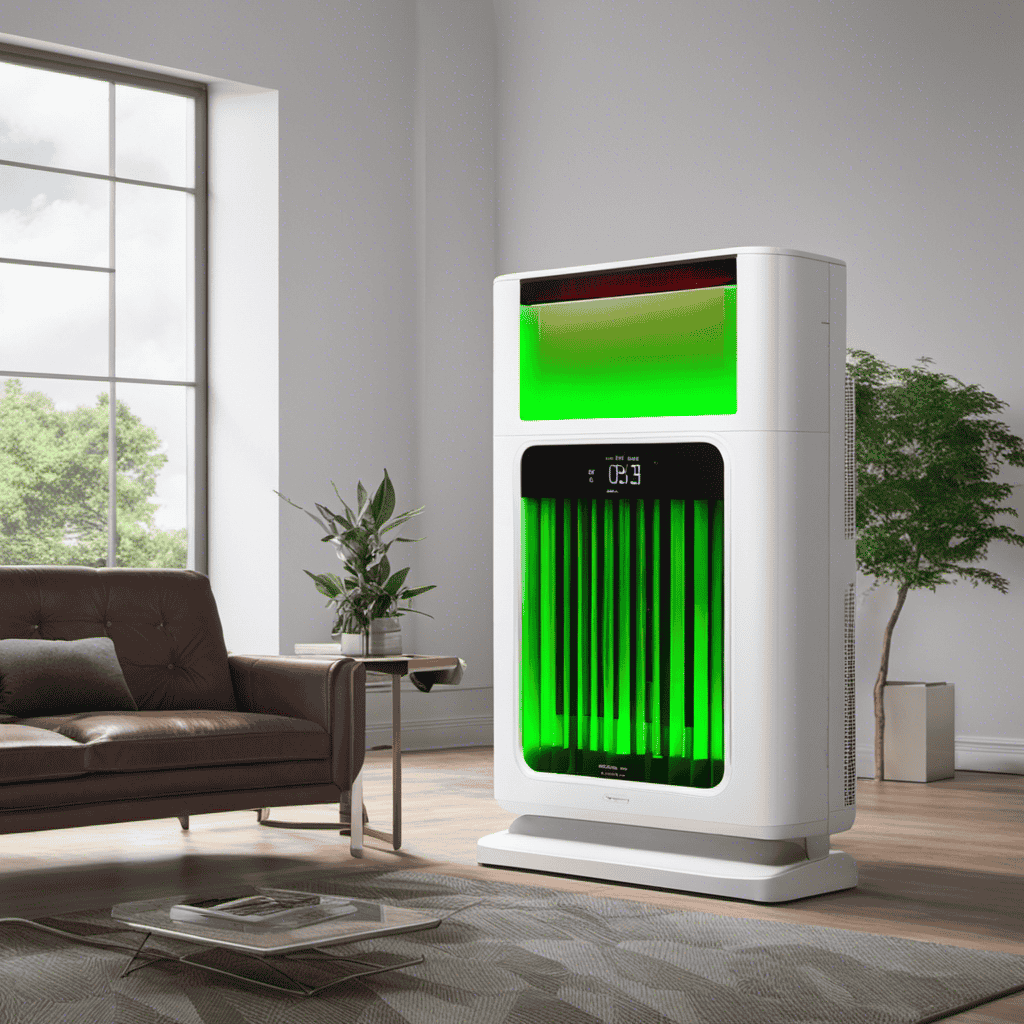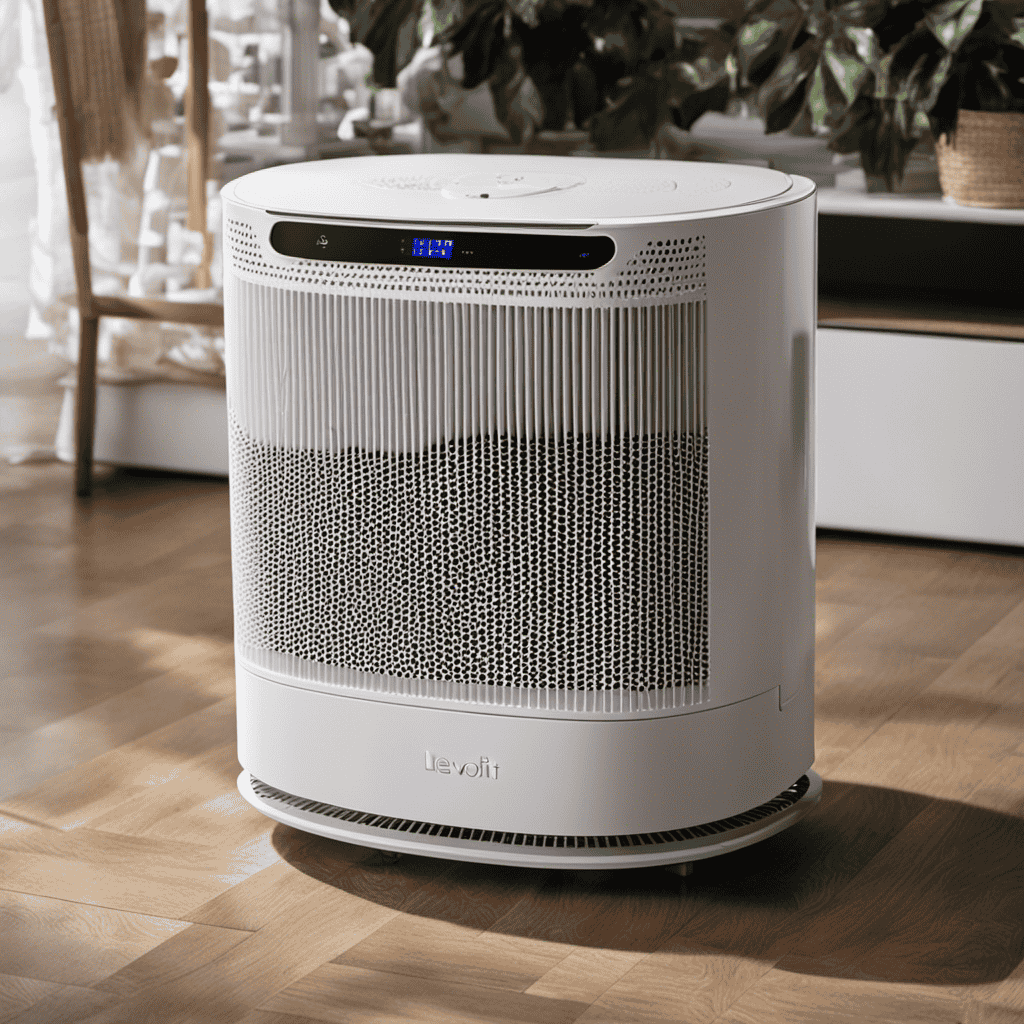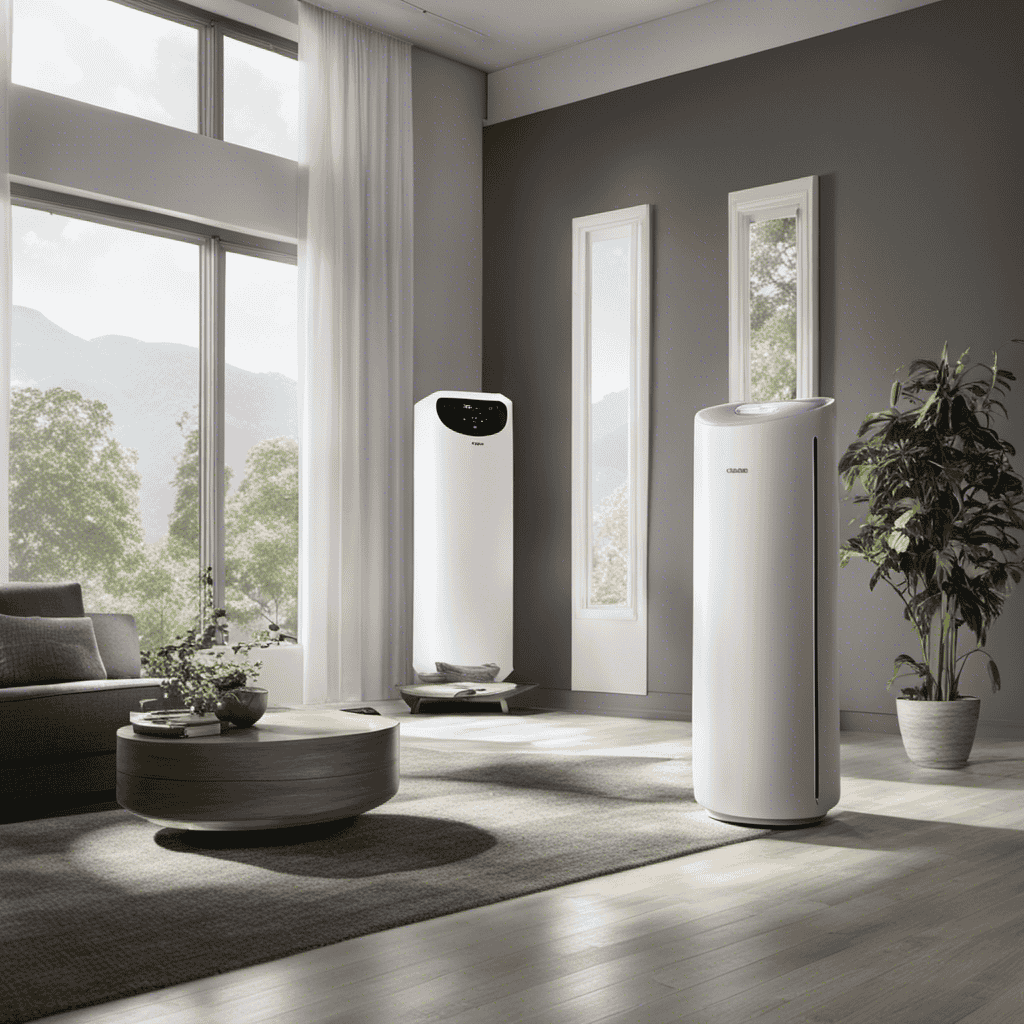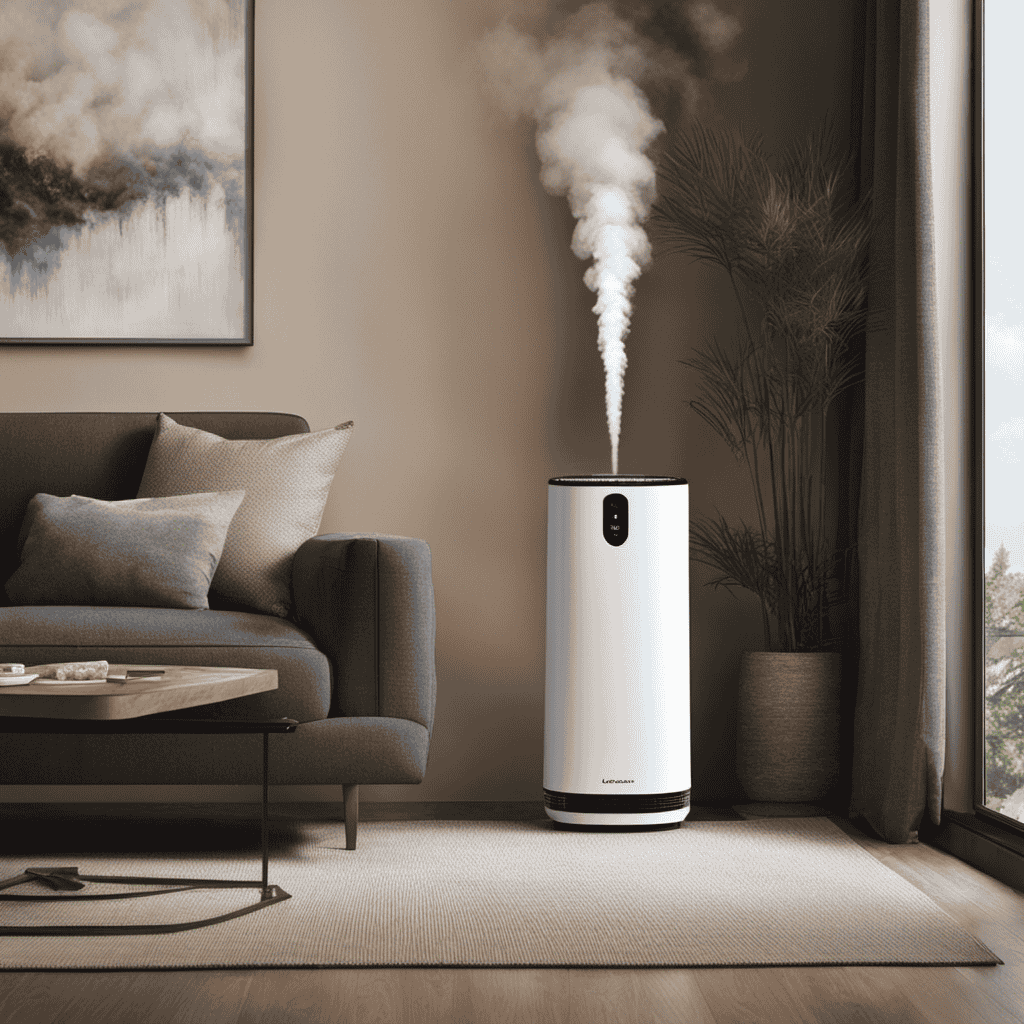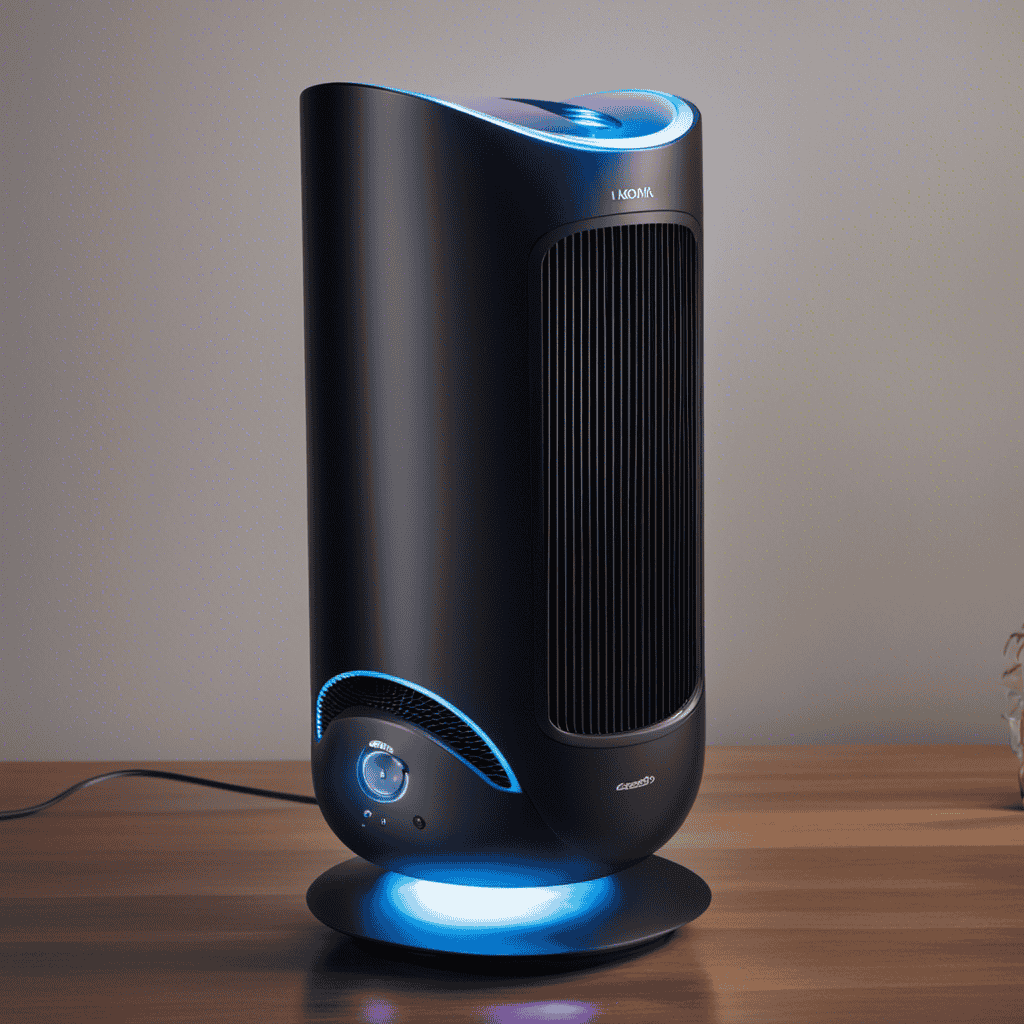You have purchased an air purifier with the intention of enjoying cleaner, fresher air in your home.
But how can you tell if it’s really doing its job? Well, fear not, because I’m here to help you navigate through the confusing world of air purifier effectiveness.
In this article, we’ll dive into the performance metrics, CADR ratings, filter efficiency, noise levels, and real-life testing to determine just how effective your air purifier is.
Get ready to breathe easy, my friend.
Key Takeaways
- Clean Air Delivery Rate (CADR) is a key metric for determining air purifier effectiveness, with higher CADR ratings indicating better performance.
- Assess the filter efficiency of air purifiers by checking the MERV rating and considering HEPA filters for capturing small particles and activated carbon filters for odors and VOCs.
- Consider noise levels when choosing an air purifier, opting for models with lower decibel levels and noise reduction technology.
- Test air purifier effectiveness in real-life conditions by monitoring air quality before and after use, evaluating improvements in allergy symptoms or respiratory issues, and comparing results with performance metrics and ratings.
Understanding Air Purifier Performance Metrics
To understand if an air purifier is effective, you should familiarize yourself with the different performance metrics. One key metric to look at is the Clean Air Delivery Rate (CADR). This metric measures the volume of clean air produced by the purifier in a specific amount of time. A higher CADR indicates a more efficient air purifier.
Another important metric is the Air Changes per Hour (ACH). This measures how many times the purifier can filter the entire room’s air in an hour. A higher ACH means more frequent air purification, making it more effective in removing pollutants.
Additionally, it’s essential to consider the type of filter used in the air purifier. HEPA filters are highly recommended, as they can capture particles as small as 0.3 microns with an efficiency of 99.97%.
Lastly, proper air purifier maintenance is crucial for its effectiveness. Regularly cleaning and replacing filters, as well as keeping the purifier in good working condition, will ensure optimal performance.
Evaluating Air Purifier CADR Ratings
Check out the CADR ratings of air purifiers to determine their effectiveness. CADR stands for Clean Air Delivery Rate, and it is a metric that measures how well an air purifier can remove specific pollutants from the air. It is an important factor to consider when evaluating air purifiers because it provides a standardized way to compare their performance.
CADR ratings are determined through testing conducted by independent organizations such as the Association of Home Appliance Manufacturers (AHAM). The higher the CADR rating, the more effective the air purifier is at removing pollutants. When comparing air purifiers, it is important to consider the CADR ratings for different pollutants such as smoke, dust, and pollen.
In addition to CADR ratings, there are other factors to consider when evaluating air purifiers. One important factor is energy consumption. Some air purifiers can consume a significant amount of energy, which can lead to higher electricity bills. It is important to consider the energy efficiency of an air purifier to ensure that it is not only effective but also cost-effective to operate.
Another factor to consider is maintenance costs. Different air purifiers require different types of filters and have varying lifespans for those filters. It is important to compare the maintenance costs of different air purifiers to ensure that you can afford to keep them running effectively.
Assessing air purifier filter efficiency is the next step in determining the overall effectiveness of an air purifier. The filter is responsible for capturing and trapping pollutants, so it is important to consider its efficiency in removing particles of different sizes. This will help ensure that the air purifier is effective in improving indoor air quality.
Assessing Air Purifier Filter Efficiency
Assessing the efficiency of your air purifier’s filter is crucial in ensuring that it effectively captures and traps pollutants of different sizes. When evaluating air purifier maintenance, it is important to compare air purifier brands and their filter performance. Different brands use various technologies and designs in their filters, which can impact their efficiency in removing airborne particles.
To assess the effectiveness of your air purifier’s filter, you can start by checking its MERV (Minimum Efficiency Reporting Value) rating. This rating indicates the filter’s ability to capture different sizes of particles. Higher MERV ratings generally indicate better filtration efficiency.
Another factor to consider is the type of filter used in the air purifier. HEPA (High-Efficiency Particulate Air) filters are known for their high capture rates of small particles, such as allergens and pollutants. Activated carbon filters are effective in removing odors and volatile organic compounds (VOCs).
Comparing air purifier brands can also help you determine which filters are more efficient. Look for independent lab tests or certifications that validate the filter’s performance. Reading customer reviews and ratings can also provide insights into the filter’s effectiveness in capturing pollutants.
Understanding and evaluating air purifier maintenance, specifically the efficiency of the filter, is vital in choosing the right air purifier for your needs. By comparing different brands and their filter performance, you can make an informed decision and ensure that your air purifier effectively improves your indoor air quality.
Analyzing air purifier noise levels, on the other hand, is another important aspect to consider.
Analyzing Air Purifier Noise Levels
When comparing air purifier brands, it’s important to consider the noise levels they produce. No one wants a noisy air purifier disrupting their peace and quiet. Here are some key factors to keep in mind when analyzing air purifier noise levels:
- Decibel levels: Look for models that operate at a lower decibel level, typically below 50 dB, to ensure a quiet and undisturbed environment.
- Fan speed settings: Some air purifiers offer multiple fan speed settings, allowing you to adjust the noise level according to your preference.
- Noise reduction technology: Certain brands incorporate advanced noise reduction technology, such as soundproofing materials or insulated chambers, to minimize noise output.
- User reviews: Reading customer reviews can provide valuable insights into the noise levels of different air purifier models.
- Testing: Look for air purifiers that have undergone independent testing for noise levels to ensure accurate and reliable information.
In addition to noise levels, it’s also important to consider other factors such as air purifier power consumption, size, and portability. Measuring air purifier power consumption can help determine its energy efficiency and potential impact on your electricity bill. Comparing air purifier size and portability is crucial if you plan on moving it around different rooms or taking it on trips. By considering these factors, you can make an informed decision when selecting an air purifier that best suits your needs and preferences.
Now that we have analyzed air purifier noise levels and other important factors, let’s move on to the next section where we will discuss testing air purifier effectiveness in real-life conditions.
Testing Air Purifier Effectiveness in Real-Life Conditions
Now that we’ve covered air purifier noise levels and other important factors, let’s dive into testing how effective air purifiers are in real-life conditions.
The effectiveness of an air purifier depends on various factors, including its technology and maintenance.
When it comes to comparing air purifier technologies, there are several options available in the market. HEPA (High-Efficiency Particulate Air) filters are widely considered the gold standard in air purification. These filters can capture up to 99.97% of particles as small as 0.3 microns, including dust, pollen, and pet dander. Another popular technology is activated carbon filters, which excel at removing odors and harmful chemicals from the air.
However, the effectiveness of an air purifier also relies on proper maintenance. Regularly cleaning or replacing the filters is crucial to ensure optimal performance. Clogged filters can hinder airflow and reduce the purifier’s ability to capture particles effectively. Additionally, it’s important to clean the purifier’s exterior and vents to prevent the build-up of dust and debris.
To test the effectiveness of an air purifier in real-life conditions, it is essential to measure the reduction of airborne pollutants over time. This can be done by monitoring the air quality before and after using the purifier. Additionally, conducting particle count tests can provide quantitative data on the purifier’s ability to remove particles of different sizes from the air.
Overall, understanding the different technologies and maintaining your air purifier properly will help ensure its effectiveness in improving indoor air quality.
Frequently Asked Questions
Are There Any Specific Air Purifier Brands That Are Known to Be More Effective Than Others?
In my opinion, when it comes to the most effective air purifier brands, there are a few factors to consider.
While there isn’t a specific brand that is universally known to be the best, some brands have a reputation for producing high-quality and efficient air purifiers. It’s important to look for brands that have a good track record, positive customer reviews, and certifications from organizations like AHAM or HEPA.
Additionally, considering your specific needs and room size can help you choose the most effective air purifier for your situation.
Can Air Purifiers Effectively Remove Odors and Smells From the Air?
Yes, air purifiers can effectively remove odors and smells from the air. I’ve personally noticed a significant improvement in the air quality when using an air purifier.
It tackles unpleasant odors caused by cigarette smoke and pet odors, leaving the air feeling fresher and cleaner. The filters in air purifiers are designed to capture and eliminate these odors, providing a more pleasant environment.
How Often Should the Filters in an Air Purifier Be Replaced?
When it comes to air purifiers, one important factor to consider is the frequency of filter replacements. It’s crucial to know how often to clean or replace the filters in order to maintain the efficiency of the device.
Signs that air purifier filters need to be replaced can include decreased airflow, a noticeable decrease in air quality, or the filter appearing dirty or clogged.
Regularly cleaning or replacing filters is essential for ensuring that your air purifier effectively removes pollutants from the air.
Can Air Purifiers Help With Allergies and Asthma Symptoms?
Air purifiers have been a game-changer for me when it comes to dealing with allergies and asthma symptoms. They have significantly reduced the amount of pet dander and indoor pollution in my home, making it easier for me to breathe.
The effectiveness of an air purifier can be determined by factors such as its CADR rating, the size of the room it’s being used in, and the type of filter it uses.
Do Air Purifiers Consume a Lot of Energy?
Air purifiers do consume some energy, but it’s not excessive. It’s important to consider the energy usage of an air purifier when deciding how long to run it.
While some purifiers may emit harmful chemicals, it’s crucial to choose one that is certified as safe.
Running an air purifier all day long may not be necessary, as it depends on factors like the size of the room and the level of air pollution.
What are the signs of an effective air purifier?
When looking for an air purifier, it’s important to watch out for effective air purifier performance indications. Look for features like a HEPA filter, CADR rating, and ACH rating to ensure it can effectively remove airborne pollutants such as dust, pollen, and pet dander, improving the air quality in your home.
Conclusion
In conclusion, evaluating the effectiveness of an air purifier requires a comprehensive assessment of its performance metrics.
The CADR ratings provide insights into the purifier’s ability to clean the air efficiently.
Additionally, the filter efficiency determines the purifier’s capability to capture pollutants effectively.
Noise levels are also crucial, as a quiet purifier ensures a peaceful environment.
Finally, testing the purifier in real-life conditions is essential to ensure its effectiveness.
Just like a skilled detective unraveling a mystery, understanding these metrics will help you choose an air purifier that truly clears the air.
